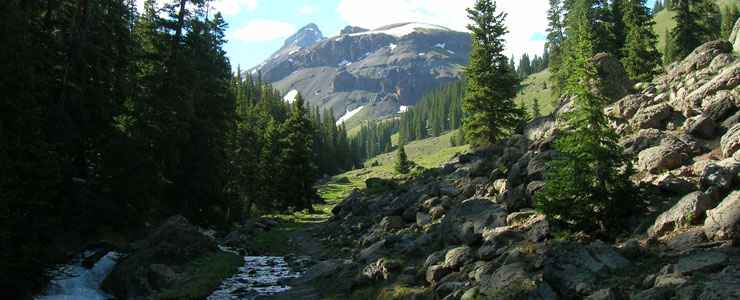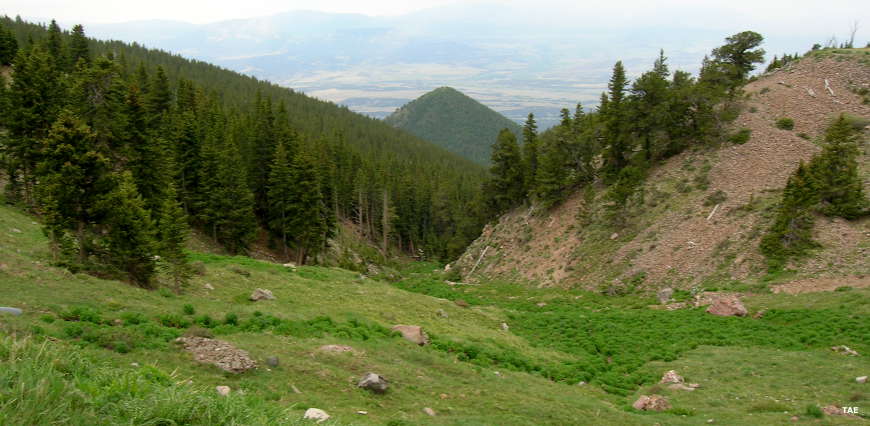National Wilderness Areas in Colorado

Looking into the heart of Uncompahgre Wilderness
Certain things are the same in just about every wilderness area:
- Permits: All profit and non-profit groups of 10 or more are required to obtain a special use permit through the local ranger district office in advance of their trip.
- Group Size: Group Size is limited to 15. Stock groups are limited to 25 with a maximum of 15 people.
- Weather: Weather patterns change quickly. Warm sunny days can turn into powerful electrical storms. Be knowledgeable of the signs of change and be prepared for cold temperatures, rain and snow, and this can happen on almost any day of the year.
- Trails: Stay on the trails where they are present. Cutting switchbacks and avoiding wet and muddy sections can cause severe erosion and multiple paths. For individuals traveling cross country, remember that alpine tundra is very susceptible to damage. Walk on durable routes of rock or talus when possible. In areas where this is not possible disperse your use so that no two footsteps land on the same spot.
- In keeping with the character of wilderness, where risk and self-reliance are part of the experience, map and route finding skills are essential.
Certain things that are always illegal:
- Entering or being in the area with more than 15 people per group, and a maximum combination of 25 people and pack or saddle animals in any one group.
- Camping within one hundred feet of any lake, stream, trail or any "No Camping" or "Wilderness Restoration Site" sign.
- Building, maintaining, attending, or using a campfire within one hundred feet of any lake, stream, trail or within 1/4 mile of tree line or above tree line.
- Storing equipment, personal property, or supplies for longer than 72 hours.
- Hitching, tethering or hobbling any pack or saddle animal within one hundred feet of any lake, stream or trail.
- Possessing a dog, except for working stock dogs or dogs used for legal hunting purposes, unless physical restrained by a leash no longer than six feet.
- Possessing, storing or transporting any plant material, such as hay, straw. NOTE: Exceptions are allowed for livestock feed that has been processed through chemical or mechanical means in a manner that will destroy viable seeds. Examples of allowed material includes pelletized feed and rolled grains.
- Possessing or using any wagon, cart or other vehicle, including a wheelbarrow or game cart.
- Shortcutting a switchback in a trail.
And in some Wilderness Areas, the following are also illegal:
Entering in or being in the wilderness without a valid wilderness use permit. Mandatory Registration Required: One member of each party is required to register at the trailhead and carry a copy of the registration with them during their visit. There is no fee for registration, permits are self issue. Permits are required in order to measure the number of visitors in the wilderness and also to educate wilderness visitors about minimizing impact.
National Forest Wilderness Areas
Buffalo Peaks
Byers Peak
Cache la Poudre
Collegiate Peaks
Comanche Peak
Eagles Nest
Flat Tops
Fossil Ridge
Greenhorn Mountain
Holy Cross
Hunter-Fryingpan
Indian Peaks
Byers Peak
Cache la Poudre
Collegiate Peaks
Comanche Peak
Eagles Nest
Flat Tops
Fossil Ridge
Greenhorn Mountain
Holy Cross
Hunter-Fryingpan
Indian Peaks
Bureau of Land Management Wilderness Areas
National Park Service Wilderness Areas
US Fish & Wildlife Service Wilderness

Greenhorn Mountain Wilderness

Photos courtesy of TheArmchairExplorer, CCA-by-SA 4.0 License
Map courtesy of Cartesia MapArt US Terrain